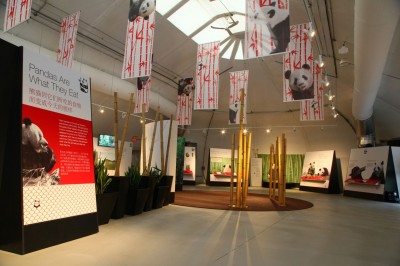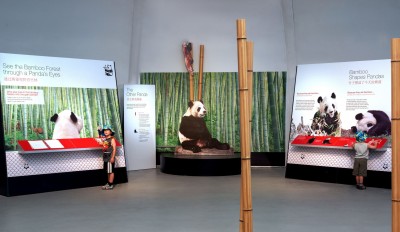
The completed interpretive centre comprises a number of themed areas. Photo courtesy Holman Exhibits
Graphic design
With Smith overseeing design of the interpretive centre’s specific layout and structure, R+P’s senior graphic designer Vivien Chow was called upon to develop the project’s approach for signage and other graphics.
“Our inspiration was modern oriental calligraphic art, which is predominantly black-and-white, with a punch of red,” she says. “We also echoed patterns and textures used in oriental textiles and gardens and mimicked motifs like the use of seal stamps and manufactured bamboo.”
Helvetica New was selected as the primary typeface to emphasize the modern feel. The team also decided only the titles and some of the introductory text would be translated into Chinese characters.
The informational graphics were redesigned throughout the process. There was a lot of back-and-forth with the interpretive designers, who sometimes rewrote text to better accommodate Chow’s graphics, but also suggested revisions to graphics so they would be better understood by visitors.
“The end result didn’t vary all that much from the original concept,” says Chow, “but we added elements, such as more bamboo graphics on banners.”
One major change, however, came when the zoo learned Er Shun was female, not male as originally assumed. This meant a panda switch was needed to ensure a breeding pair.
“We had incorporated into our graphics the story of Ji Li, a female panda, but then she had to be switched out for the male Da Mao,” says Smith. “As a nod to Ji Li, she’s still included in a ‘panda mating game’ exhibit.”

Indoor displays used screenprinted vinyl mounted onto expanded closed-cell PVC boards. Photos courtesy R+P
AV systems
Ottawa-based Global Exhibit Technology and the Toronto-based Design Foundation handled the interpretive centre’s AV elements. Specifically, the former supplied systems and managed the project, while the latter shot video content and configured the interactive screens.
“As the project authority, R+P got the information for us about the AV design,” says Ted Ratcliffe, Global Exhibit partner and project manager. “We set up the 4.3-m (14.1-ft) ‘bamboo tree planting’ video wall with an infrared (IR) multi-touch detector, as well three interactive screens for the ‘find the panda’ game, which allows visitors to zoom in on pandas in their habitats.”
While R+P did not work directly on any of the digital signage, Chow provided her graphic design files to the Design Foundation to integrate into the on-screen content.
“They used our bamboo texture, for example, in their ‘meet the experts’ footage,” she says.
The interpretive centre’s AV design also saw relatively last-minute changes, as more equipment was donated by corporate sponsors.
“The ‘find the panda’ game was enhanced right before the exhibit opened with the addition of large monitors overhead, which let other people see what’s going on,” says Smith. “Also, Federal Express (FedEx) has donated monitors that show content explaining how they delivered the pandas from China to Canada.”





